Report: Training and Development for Comfort Delgro Employees
VerifiedAdded on 2022/08/28
|10
|2199
|16
Report
AI Summary
This report focuses on the training and development needs of Comfort Delgro, a land transport company, aiming to enhance its employees' capabilities for autonomous vehicle manufacturing. It outlines suitable WSQ and non-WSQ training programs, including team work, communication, and technical skills, and provides the rationale behind these choices. The report details learning outcomes based on SOLO taxonomy, assessment methods, resource requirements, and budget considerations. It also addresses the selection of trainers and the overall validity and reliability of the proposed training program. The goal is to make the employees innovative and creative in their approach to autonomous vehicle manufacturing within six months. The report emphasizes the importance of enhancing employee skills to achieve the company's goal of becoming the world’s choice for land transport.
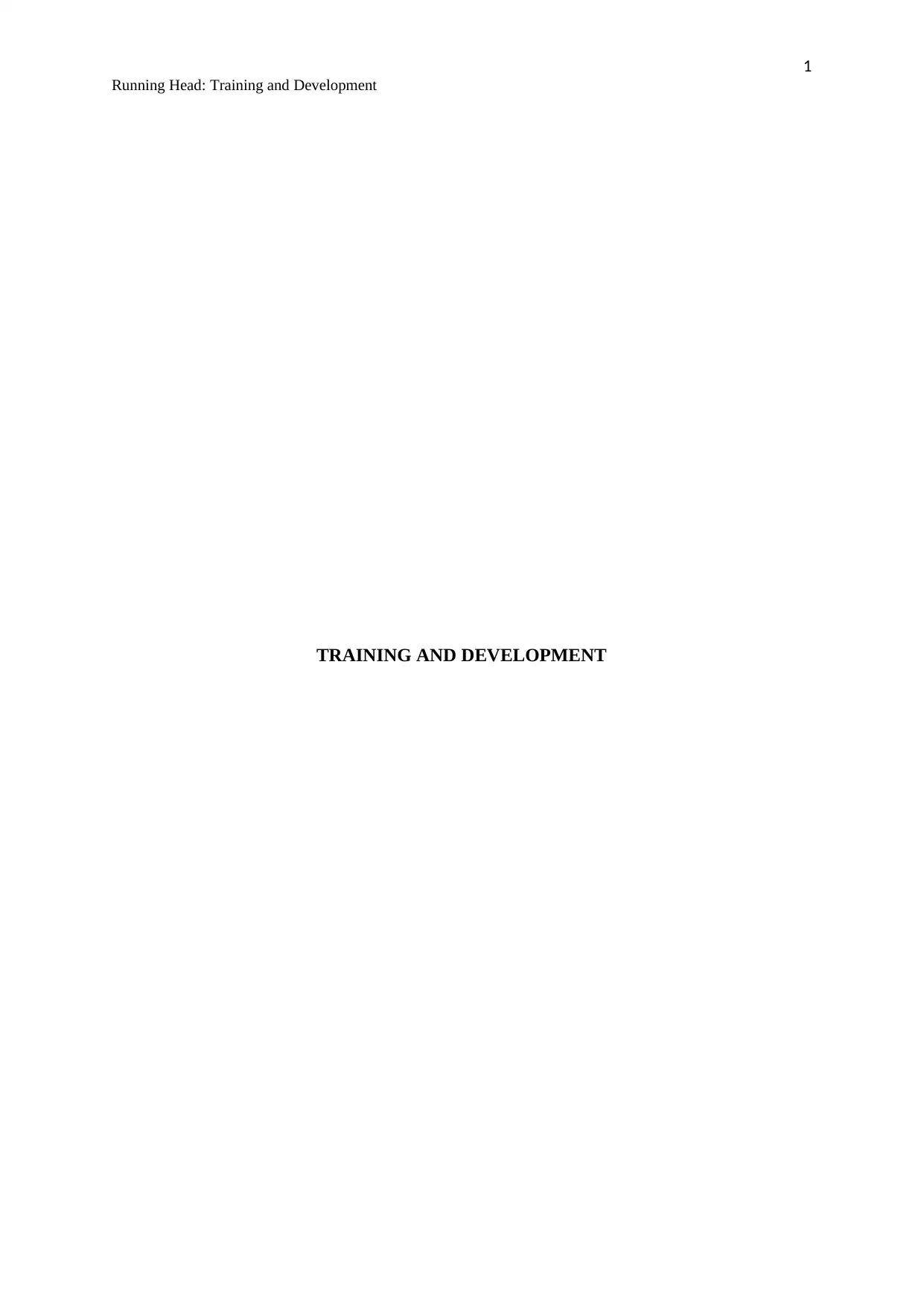
1
Running Head: Training and Development
TRAINING AND DEVELOPMENT
Running Head: Training and Development
TRAINING AND DEVELOPMENT
Paraphrase This Document
Need a fresh take? Get an instant paraphrase of this document with our AI Paraphraser
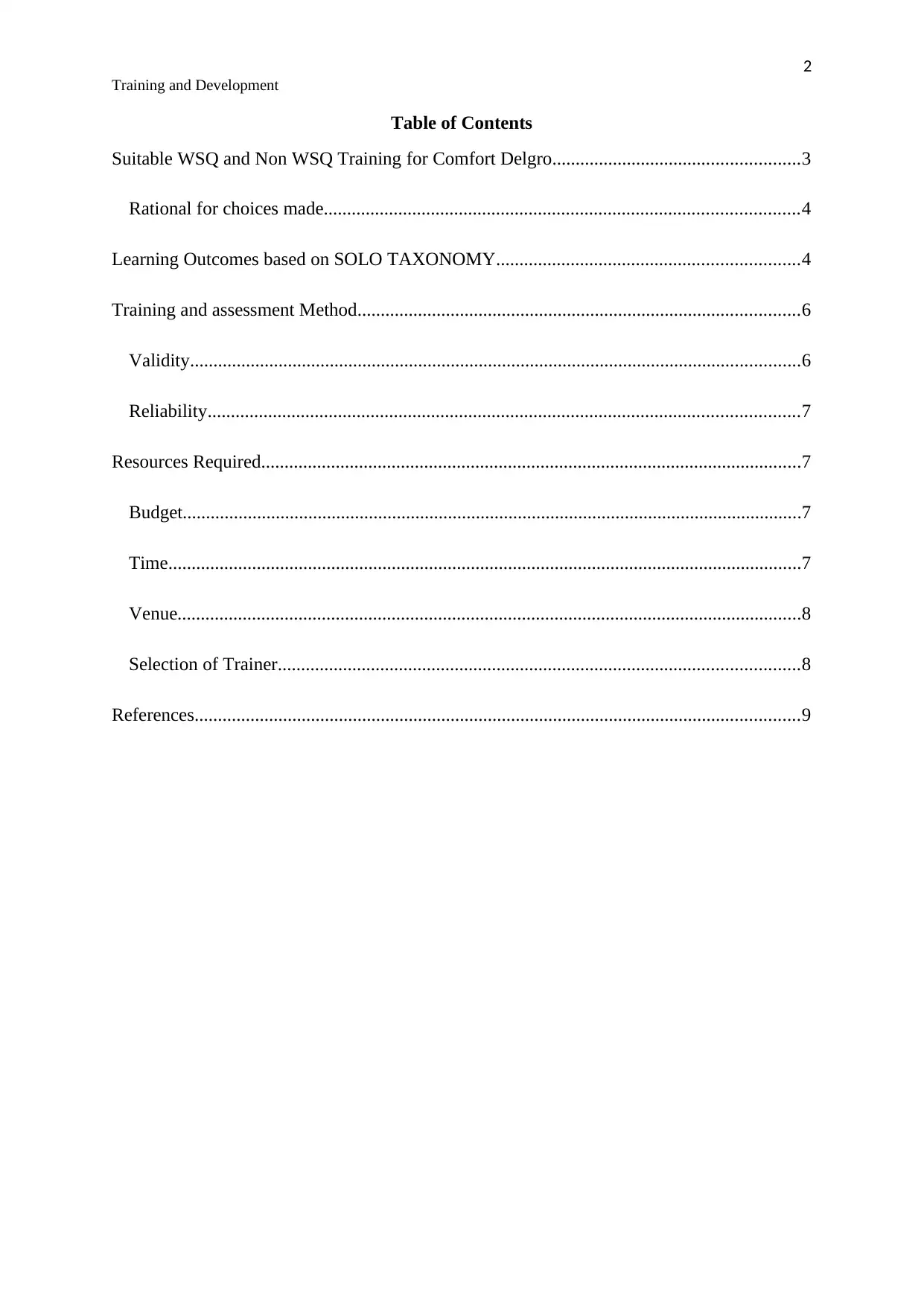
2
Training and Development
Table of Contents
Suitable WSQ and Non WSQ Training for Comfort Delgro.....................................................3
Rational for choices made......................................................................................................4
Learning Outcomes based on SOLO TAXONOMY.................................................................4
Training and assessment Method...............................................................................................6
Validity...................................................................................................................................6
Reliability...............................................................................................................................7
Resources Required....................................................................................................................7
Budget.....................................................................................................................................7
Time........................................................................................................................................7
Venue......................................................................................................................................8
Selection of Trainer................................................................................................................8
References..................................................................................................................................9
Training and Development
Table of Contents
Suitable WSQ and Non WSQ Training for Comfort Delgro.....................................................3
Rational for choices made......................................................................................................4
Learning Outcomes based on SOLO TAXONOMY.................................................................4
Training and assessment Method...............................................................................................6
Validity...................................................................................................................................6
Reliability...............................................................................................................................7
Resources Required....................................................................................................................7
Budget.....................................................................................................................................7
Time........................................................................................................................................7
Venue......................................................................................................................................8
Selection of Trainer................................................................................................................8
References..................................................................................................................................9
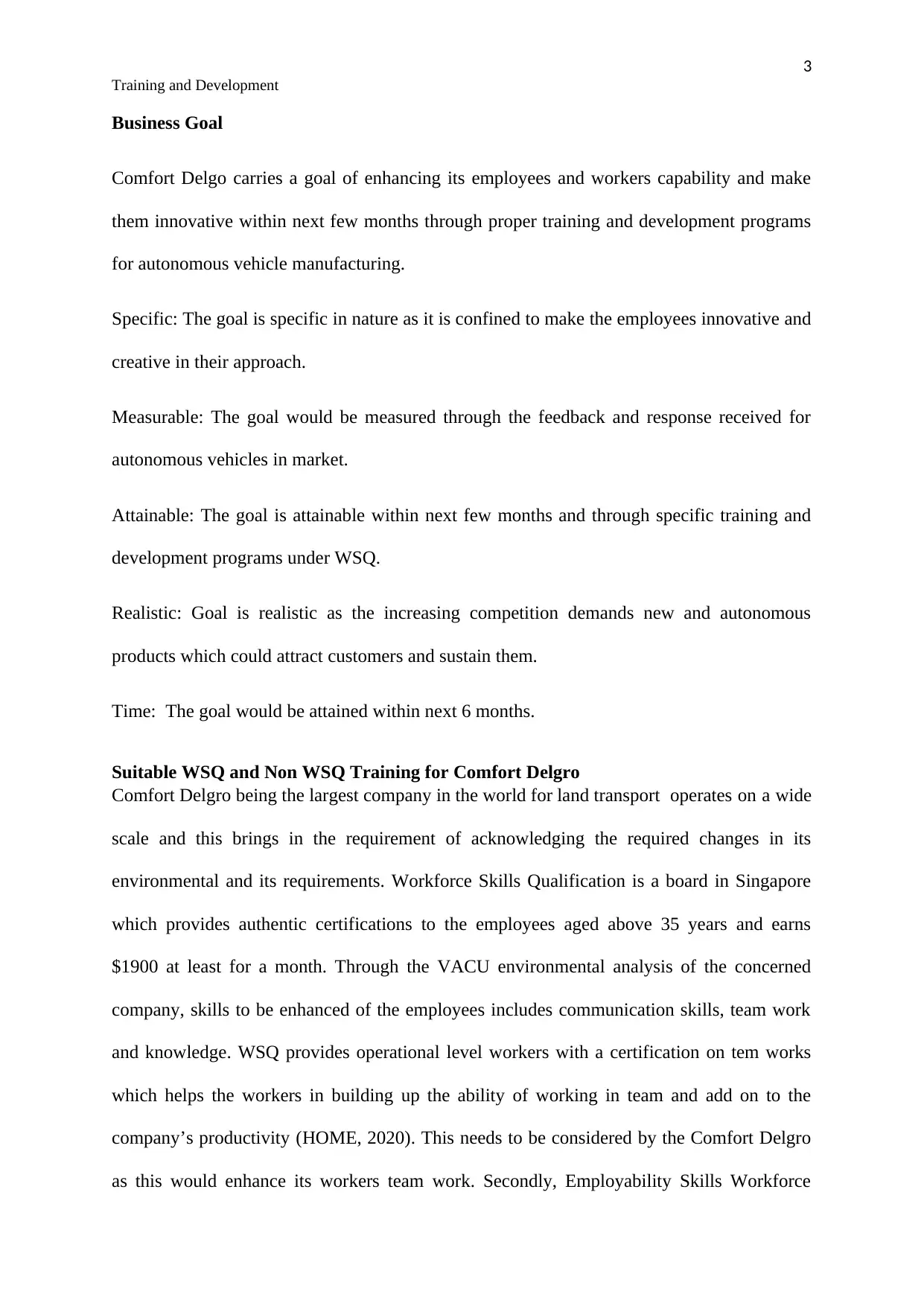
3
Training and Development
Business Goal
Comfort Delgo carries a goal of enhancing its employees and workers capability and make
them innovative within next few months through proper training and development programs
for autonomous vehicle manufacturing.
Specific: The goal is specific in nature as it is confined to make the employees innovative and
creative in their approach.
Measurable: The goal would be measured through the feedback and response received for
autonomous vehicles in market.
Attainable: The goal is attainable within next few months and through specific training and
development programs under WSQ.
Realistic: Goal is realistic as the increasing competition demands new and autonomous
products which could attract customers and sustain them.
Time: The goal would be attained within next 6 months.
Suitable WSQ and Non WSQ Training for Comfort Delgro
Comfort Delgro being the largest company in the world for land transport operates on a wide
scale and this brings in the requirement of acknowledging the required changes in its
environmental and its requirements. Workforce Skills Qualification is a board in Singapore
which provides authentic certifications to the employees aged above 35 years and earns
$1900 at least for a month. Through the VACU environmental analysis of the concerned
company, skills to be enhanced of the employees includes communication skills, team work
and knowledge. WSQ provides operational level workers with a certification on tem works
which helps the workers in building up the ability of working in team and add on to the
company’s productivity (HOME, 2020). This needs to be considered by the Comfort Delgro
as this would enhance its workers team work. Secondly, Employability Skills Workforce
Training and Development
Business Goal
Comfort Delgo carries a goal of enhancing its employees and workers capability and make
them innovative within next few months through proper training and development programs
for autonomous vehicle manufacturing.
Specific: The goal is specific in nature as it is confined to make the employees innovative and
creative in their approach.
Measurable: The goal would be measured through the feedback and response received for
autonomous vehicles in market.
Attainable: The goal is attainable within next few months and through specific training and
development programs under WSQ.
Realistic: Goal is realistic as the increasing competition demands new and autonomous
products which could attract customers and sustain them.
Time: The goal would be attained within next 6 months.
Suitable WSQ and Non WSQ Training for Comfort Delgro
Comfort Delgro being the largest company in the world for land transport operates on a wide
scale and this brings in the requirement of acknowledging the required changes in its
environmental and its requirements. Workforce Skills Qualification is a board in Singapore
which provides authentic certifications to the employees aged above 35 years and earns
$1900 at least for a month. Through the VACU environmental analysis of the concerned
company, skills to be enhanced of the employees includes communication skills, team work
and knowledge. WSQ provides operational level workers with a certification on tem works
which helps the workers in building up the ability of working in team and add on to the
company’s productivity (HOME, 2020). This needs to be considered by the Comfort Delgro
as this would enhance its workers team work. Secondly, Employability Skills Workforce
⊘ This is a preview!⊘
Do you want full access?
Subscribe today to unlock all pages.

Trusted by 1+ million students worldwide
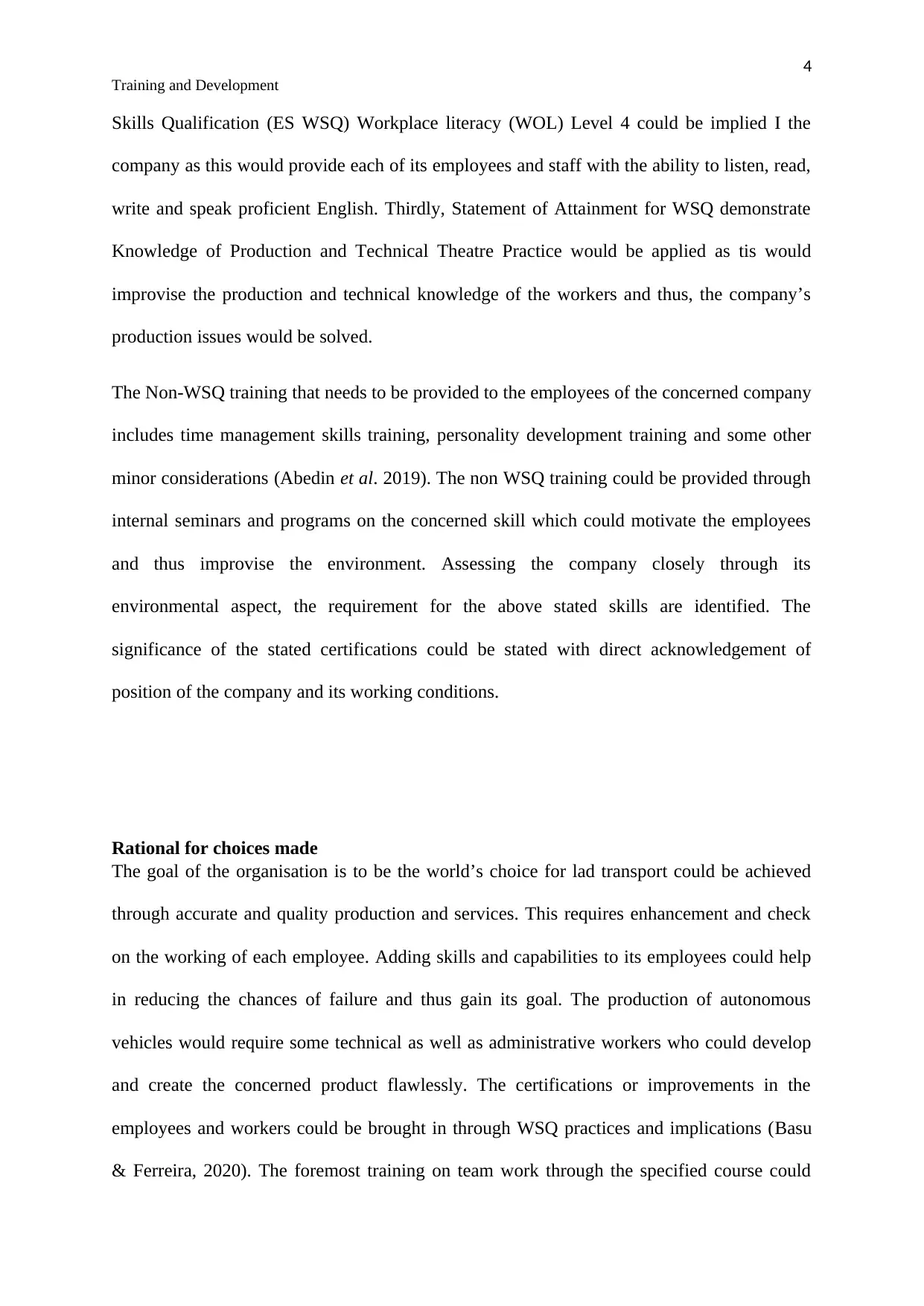
4
Training and Development
Skills Qualification (ES WSQ) Workplace literacy (WOL) Level 4 could be implied I the
company as this would provide each of its employees and staff with the ability to listen, read,
write and speak proficient English. Thirdly, Statement of Attainment for WSQ demonstrate
Knowledge of Production and Technical Theatre Practice would be applied as tis would
improvise the production and technical knowledge of the workers and thus, the company’s
production issues would be solved.
The Non-WSQ training that needs to be provided to the employees of the concerned company
includes time management skills training, personality development training and some other
minor considerations (Abedin et al. 2019). The non WSQ training could be provided through
internal seminars and programs on the concerned skill which could motivate the employees
and thus improvise the environment. Assessing the company closely through its
environmental aspect, the requirement for the above stated skills are identified. The
significance of the stated certifications could be stated with direct acknowledgement of
position of the company and its working conditions.
Rational for choices made
The goal of the organisation is to be the world’s choice for lad transport could be achieved
through accurate and quality production and services. This requires enhancement and check
on the working of each employee. Adding skills and capabilities to its employees could help
in reducing the chances of failure and thus gain its goal. The production of autonomous
vehicles would require some technical as well as administrative workers who could develop
and create the concerned product flawlessly. The certifications or improvements in the
employees and workers could be brought in through WSQ practices and implications (Basu
& Ferreira, 2020). The foremost training on team work through the specified course could
Training and Development
Skills Qualification (ES WSQ) Workplace literacy (WOL) Level 4 could be implied I the
company as this would provide each of its employees and staff with the ability to listen, read,
write and speak proficient English. Thirdly, Statement of Attainment for WSQ demonstrate
Knowledge of Production and Technical Theatre Practice would be applied as tis would
improvise the production and technical knowledge of the workers and thus, the company’s
production issues would be solved.
The Non-WSQ training that needs to be provided to the employees of the concerned company
includes time management skills training, personality development training and some other
minor considerations (Abedin et al. 2019). The non WSQ training could be provided through
internal seminars and programs on the concerned skill which could motivate the employees
and thus improvise the environment. Assessing the company closely through its
environmental aspect, the requirement for the above stated skills are identified. The
significance of the stated certifications could be stated with direct acknowledgement of
position of the company and its working conditions.
Rational for choices made
The goal of the organisation is to be the world’s choice for lad transport could be achieved
through accurate and quality production and services. This requires enhancement and check
on the working of each employee. Adding skills and capabilities to its employees could help
in reducing the chances of failure and thus gain its goal. The production of autonomous
vehicles would require some technical as well as administrative workers who could develop
and create the concerned product flawlessly. The certifications or improvements in the
employees and workers could be brought in through WSQ practices and implications (Basu
& Ferreira, 2020). The foremost training on team work through the specified course could
Paraphrase This Document
Need a fresh take? Get an instant paraphrase of this document with our AI Paraphraser
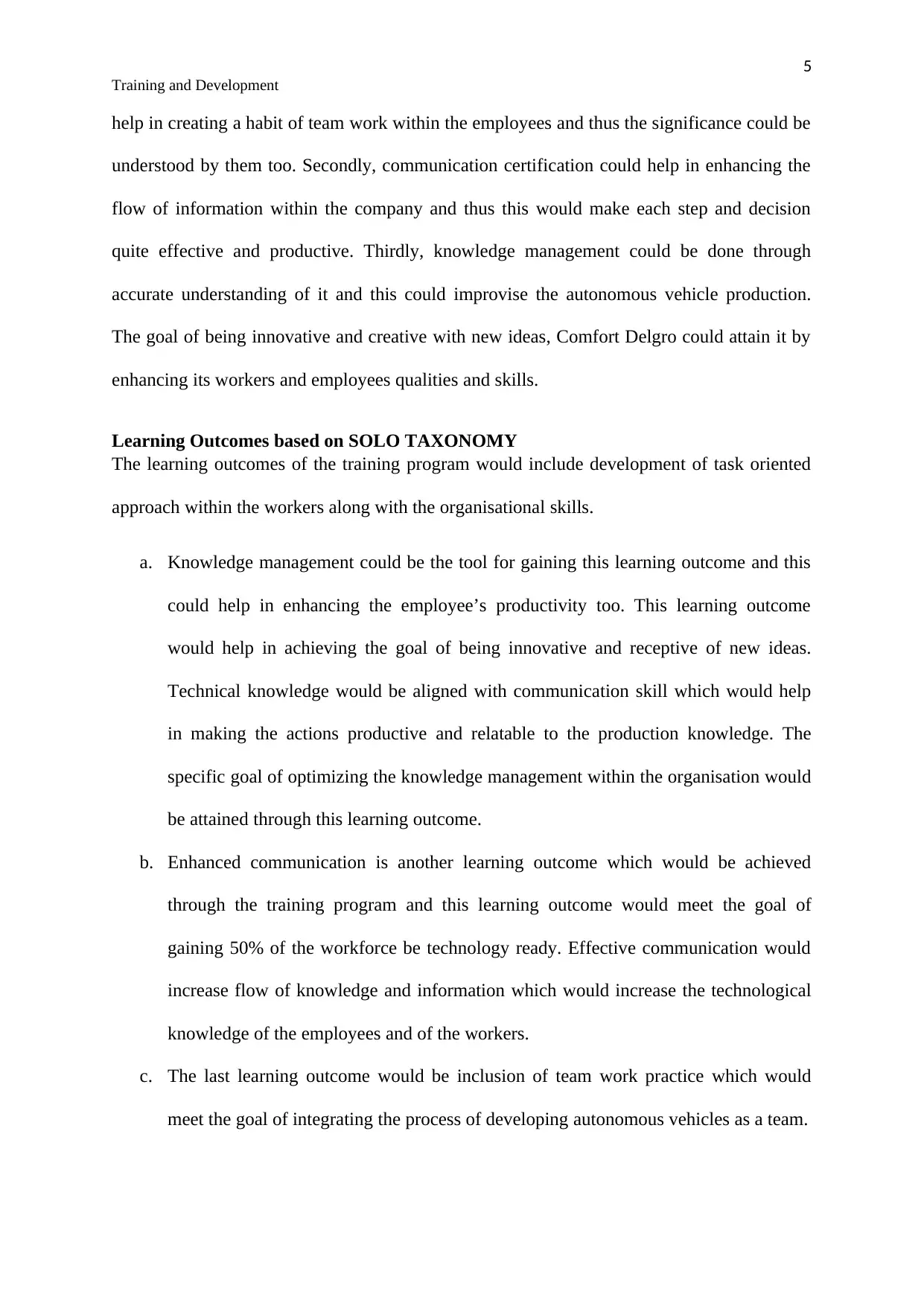
5
Training and Development
help in creating a habit of team work within the employees and thus the significance could be
understood by them too. Secondly, communication certification could help in enhancing the
flow of information within the company and thus this would make each step and decision
quite effective and productive. Thirdly, knowledge management could be done through
accurate understanding of it and this could improvise the autonomous vehicle production.
The goal of being innovative and creative with new ideas, Comfort Delgro could attain it by
enhancing its workers and employees qualities and skills.
Learning Outcomes based on SOLO TAXONOMY
The learning outcomes of the training program would include development of task oriented
approach within the workers along with the organisational skills.
a. Knowledge management could be the tool for gaining this learning outcome and this
could help in enhancing the employee’s productivity too. This learning outcome
would help in achieving the goal of being innovative and receptive of new ideas.
Technical knowledge would be aligned with communication skill which would help
in making the actions productive and relatable to the production knowledge. The
specific goal of optimizing the knowledge management within the organisation would
be attained through this learning outcome.
b. Enhanced communication is another learning outcome which would be achieved
through the training program and this learning outcome would meet the goal of
gaining 50% of the workforce be technology ready. Effective communication would
increase flow of knowledge and information which would increase the technological
knowledge of the employees and of the workers.
c. The last learning outcome would be inclusion of team work practice which would
meet the goal of integrating the process of developing autonomous vehicles as a team.
Training and Development
help in creating a habit of team work within the employees and thus the significance could be
understood by them too. Secondly, communication certification could help in enhancing the
flow of information within the company and thus this would make each step and decision
quite effective and productive. Thirdly, knowledge management could be done through
accurate understanding of it and this could improvise the autonomous vehicle production.
The goal of being innovative and creative with new ideas, Comfort Delgro could attain it by
enhancing its workers and employees qualities and skills.
Learning Outcomes based on SOLO TAXONOMY
The learning outcomes of the training program would include development of task oriented
approach within the workers along with the organisational skills.
a. Knowledge management could be the tool for gaining this learning outcome and this
could help in enhancing the employee’s productivity too. This learning outcome
would help in achieving the goal of being innovative and receptive of new ideas.
Technical knowledge would be aligned with communication skill which would help
in making the actions productive and relatable to the production knowledge. The
specific goal of optimizing the knowledge management within the organisation would
be attained through this learning outcome.
b. Enhanced communication is another learning outcome which would be achieved
through the training program and this learning outcome would meet the goal of
gaining 50% of the workforce be technology ready. Effective communication would
increase flow of knowledge and information which would increase the technological
knowledge of the employees and of the workers.
c. The last learning outcome would be inclusion of team work practice which would
meet the goal of integrating the process of developing autonomous vehicles as a team.
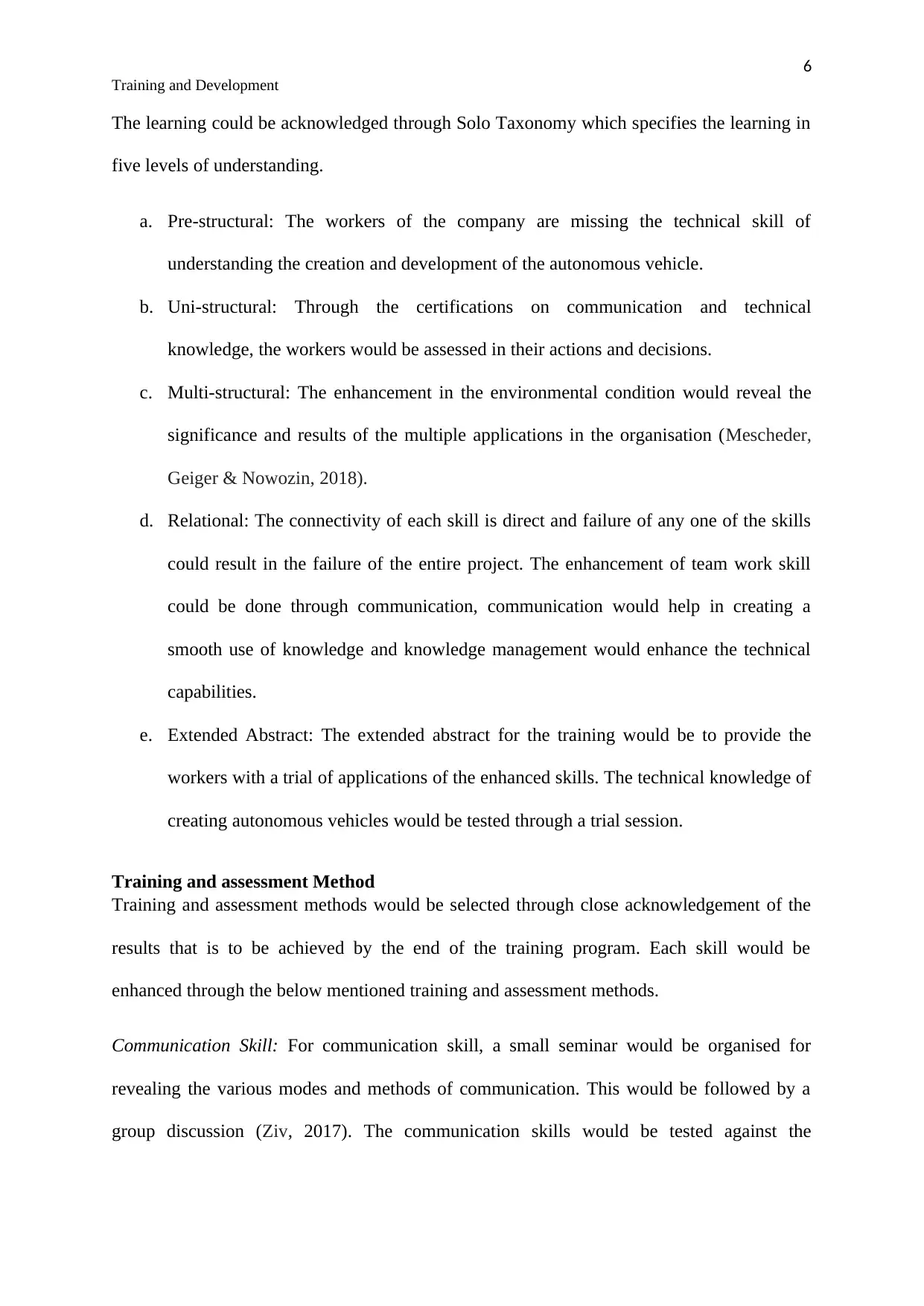
6
Training and Development
The learning could be acknowledged through Solo Taxonomy which specifies the learning in
five levels of understanding.
a. Pre-structural: The workers of the company are missing the technical skill of
understanding the creation and development of the autonomous vehicle.
b. Uni-structural: Through the certifications on communication and technical
knowledge, the workers would be assessed in their actions and decisions.
c. Multi-structural: The enhancement in the environmental condition would reveal the
significance and results of the multiple applications in the organisation (Mescheder,
Geiger & Nowozin, 2018).
d. Relational: The connectivity of each skill is direct and failure of any one of the skills
could result in the failure of the entire project. The enhancement of team work skill
could be done through communication, communication would help in creating a
smooth use of knowledge and knowledge management would enhance the technical
capabilities.
e. Extended Abstract: The extended abstract for the training would be to provide the
workers with a trial of applications of the enhanced skills. The technical knowledge of
creating autonomous vehicles would be tested through a trial session.
Training and assessment Method
Training and assessment methods would be selected through close acknowledgement of the
results that is to be achieved by the end of the training program. Each skill would be
enhanced through the below mentioned training and assessment methods.
Communication Skill: For communication skill, a small seminar would be organised for
revealing the various modes and methods of communication. This would be followed by a
group discussion (Ziv, 2017). The communication skills would be tested against the
Training and Development
The learning could be acknowledged through Solo Taxonomy which specifies the learning in
five levels of understanding.
a. Pre-structural: The workers of the company are missing the technical skill of
understanding the creation and development of the autonomous vehicle.
b. Uni-structural: Through the certifications on communication and technical
knowledge, the workers would be assessed in their actions and decisions.
c. Multi-structural: The enhancement in the environmental condition would reveal the
significance and results of the multiple applications in the organisation (Mescheder,
Geiger & Nowozin, 2018).
d. Relational: The connectivity of each skill is direct and failure of any one of the skills
could result in the failure of the entire project. The enhancement of team work skill
could be done through communication, communication would help in creating a
smooth use of knowledge and knowledge management would enhance the technical
capabilities.
e. Extended Abstract: The extended abstract for the training would be to provide the
workers with a trial of applications of the enhanced skills. The technical knowledge of
creating autonomous vehicles would be tested through a trial session.
Training and assessment Method
Training and assessment methods would be selected through close acknowledgement of the
results that is to be achieved by the end of the training program. Each skill would be
enhanced through the below mentioned training and assessment methods.
Communication Skill: For communication skill, a small seminar would be organised for
revealing the various modes and methods of communication. This would be followed by a
group discussion (Ziv, 2017). The communication skills would be tested against the
⊘ This is a preview!⊘
Do you want full access?
Subscribe today to unlock all pages.

Trusted by 1+ million students worldwide
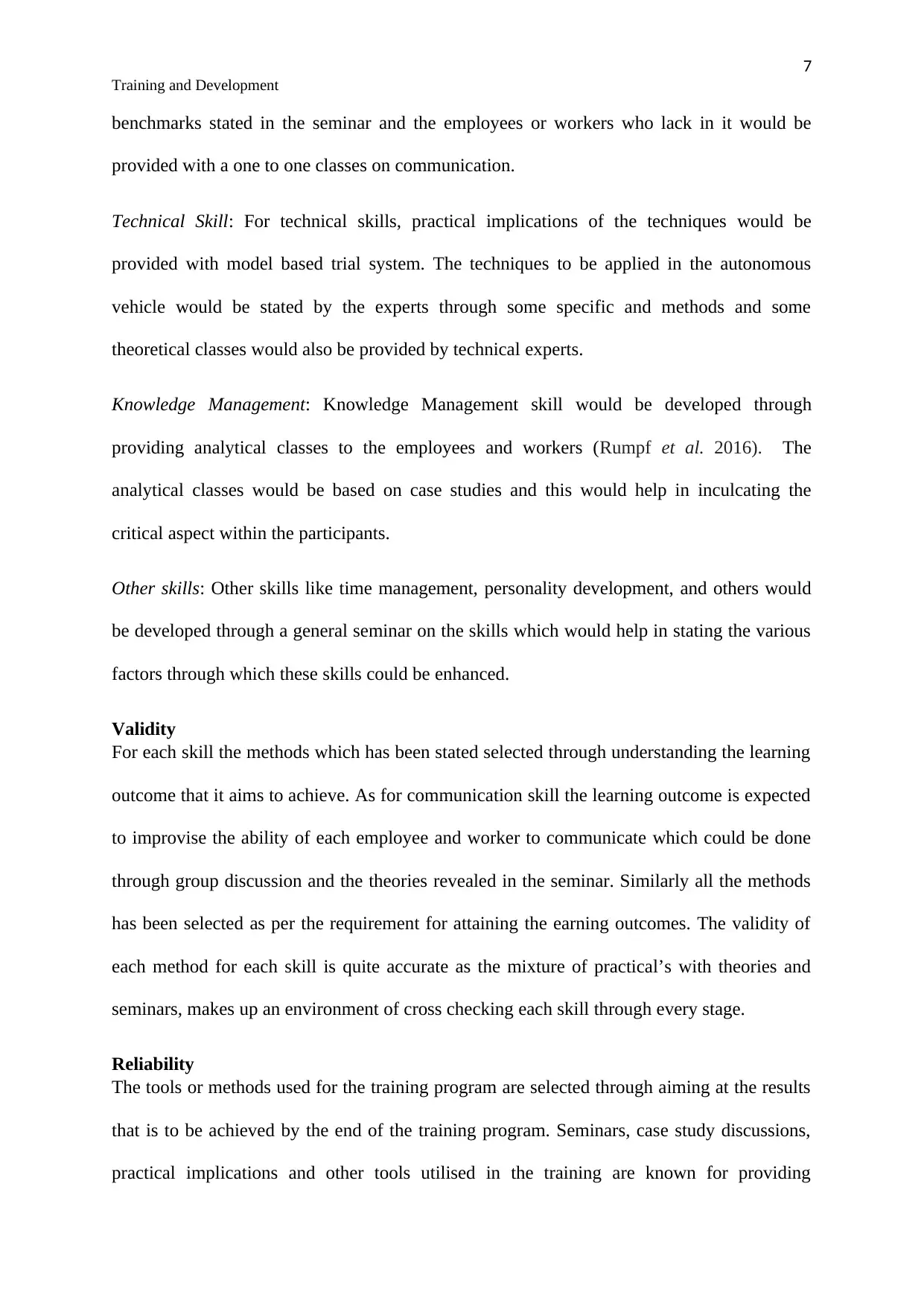
7
Training and Development
benchmarks stated in the seminar and the employees or workers who lack in it would be
provided with a one to one classes on communication.
Technical Skill: For technical skills, practical implications of the techniques would be
provided with model based trial system. The techniques to be applied in the autonomous
vehicle would be stated by the experts through some specific and methods and some
theoretical classes would also be provided by technical experts.
Knowledge Management: Knowledge Management skill would be developed through
providing analytical classes to the employees and workers (Rumpf et al. 2016). The
analytical classes would be based on case studies and this would help in inculcating the
critical aspect within the participants.
Other skills: Other skills like time management, personality development, and others would
be developed through a general seminar on the skills which would help in stating the various
factors through which these skills could be enhanced.
Validity
For each skill the methods which has been stated selected through understanding the learning
outcome that it aims to achieve. As for communication skill the learning outcome is expected
to improvise the ability of each employee and worker to communicate which could be done
through group discussion and the theories revealed in the seminar. Similarly all the methods
has been selected as per the requirement for attaining the earning outcomes. The validity of
each method for each skill is quite accurate as the mixture of practical’s with theories and
seminars, makes up an environment of cross checking each skill through every stage.
Reliability
The tools or methods used for the training program are selected through aiming at the results
that is to be achieved by the end of the training program. Seminars, case study discussions,
practical implications and other tools utilised in the training are known for providing
Training and Development
benchmarks stated in the seminar and the employees or workers who lack in it would be
provided with a one to one classes on communication.
Technical Skill: For technical skills, practical implications of the techniques would be
provided with model based trial system. The techniques to be applied in the autonomous
vehicle would be stated by the experts through some specific and methods and some
theoretical classes would also be provided by technical experts.
Knowledge Management: Knowledge Management skill would be developed through
providing analytical classes to the employees and workers (Rumpf et al. 2016). The
analytical classes would be based on case studies and this would help in inculcating the
critical aspect within the participants.
Other skills: Other skills like time management, personality development, and others would
be developed through a general seminar on the skills which would help in stating the various
factors through which these skills could be enhanced.
Validity
For each skill the methods which has been stated selected through understanding the learning
outcome that it aims to achieve. As for communication skill the learning outcome is expected
to improvise the ability of each employee and worker to communicate which could be done
through group discussion and the theories revealed in the seminar. Similarly all the methods
has been selected as per the requirement for attaining the earning outcomes. The validity of
each method for each skill is quite accurate as the mixture of practical’s with theories and
seminars, makes up an environment of cross checking each skill through every stage.
Reliability
The tools or methods used for the training program are selected through aiming at the results
that is to be achieved by the end of the training program. Seminars, case study discussions,
practical implications and other tools utilised in the training are known for providing
Paraphrase This Document
Need a fresh take? Get an instant paraphrase of this document with our AI Paraphraser
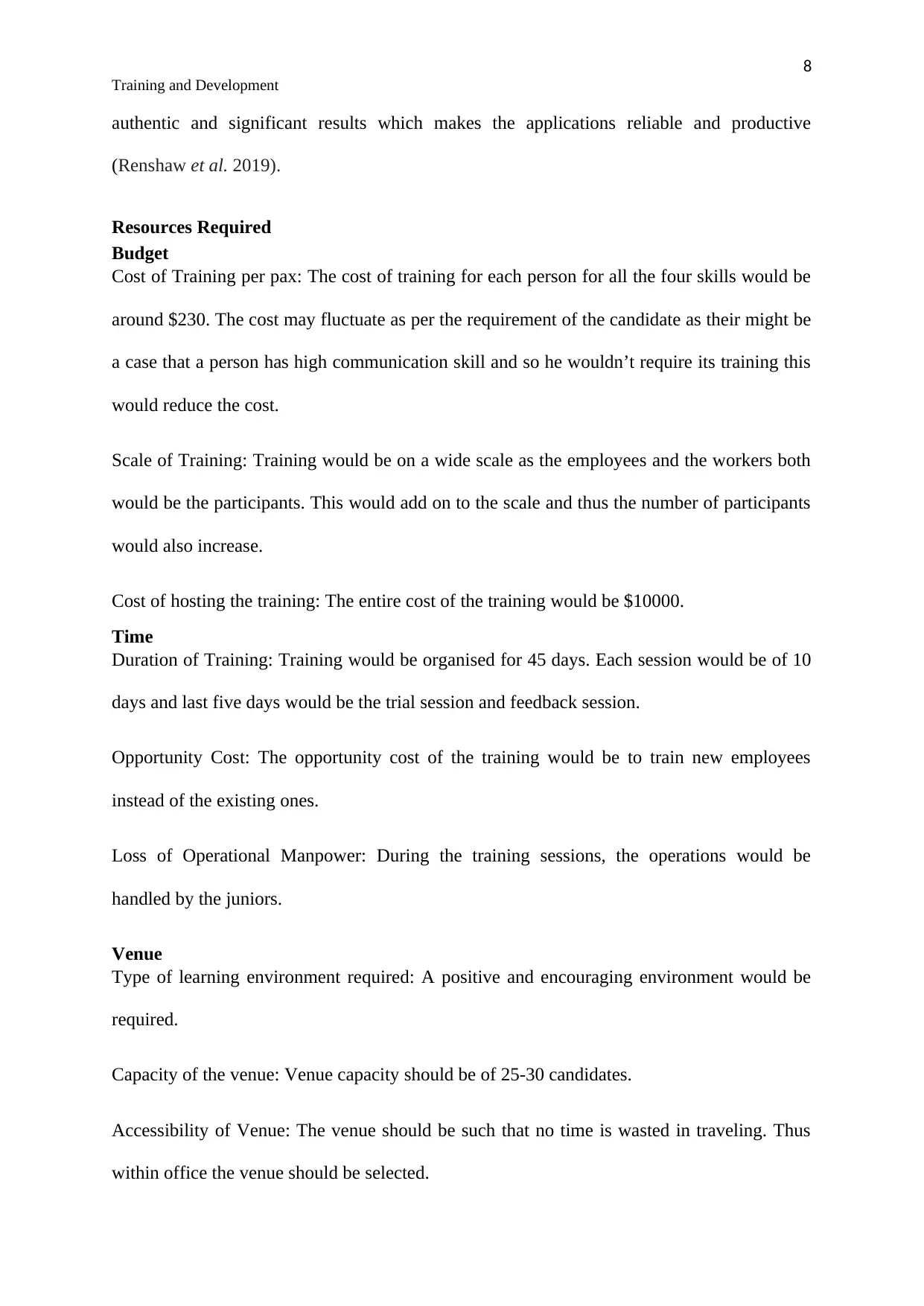
8
Training and Development
authentic and significant results which makes the applications reliable and productive
(Renshaw et al. 2019).
Resources Required
Budget
Cost of Training per pax: The cost of training for each person for all the four skills would be
around $230. The cost may fluctuate as per the requirement of the candidate as their might be
a case that a person has high communication skill and so he wouldn’t require its training this
would reduce the cost.
Scale of Training: Training would be on a wide scale as the employees and the workers both
would be the participants. This would add on to the scale and thus the number of participants
would also increase.
Cost of hosting the training: The entire cost of the training would be $10000.
Time
Duration of Training: Training would be organised for 45 days. Each session would be of 10
days and last five days would be the trial session and feedback session.
Opportunity Cost: The opportunity cost of the training would be to train new employees
instead of the existing ones.
Loss of Operational Manpower: During the training sessions, the operations would be
handled by the juniors.
Venue
Type of learning environment required: A positive and encouraging environment would be
required.
Capacity of the venue: Venue capacity should be of 25-30 candidates.
Accessibility of Venue: The venue should be such that no time is wasted in traveling. Thus
within office the venue should be selected.
Training and Development
authentic and significant results which makes the applications reliable and productive
(Renshaw et al. 2019).
Resources Required
Budget
Cost of Training per pax: The cost of training for each person for all the four skills would be
around $230. The cost may fluctuate as per the requirement of the candidate as their might be
a case that a person has high communication skill and so he wouldn’t require its training this
would reduce the cost.
Scale of Training: Training would be on a wide scale as the employees and the workers both
would be the participants. This would add on to the scale and thus the number of participants
would also increase.
Cost of hosting the training: The entire cost of the training would be $10000.
Time
Duration of Training: Training would be organised for 45 days. Each session would be of 10
days and last five days would be the trial session and feedback session.
Opportunity Cost: The opportunity cost of the training would be to train new employees
instead of the existing ones.
Loss of Operational Manpower: During the training sessions, the operations would be
handled by the juniors.
Venue
Type of learning environment required: A positive and encouraging environment would be
required.
Capacity of the venue: Venue capacity should be of 25-30 candidates.
Accessibility of Venue: The venue should be such that no time is wasted in traveling. Thus
within office the venue should be selected.
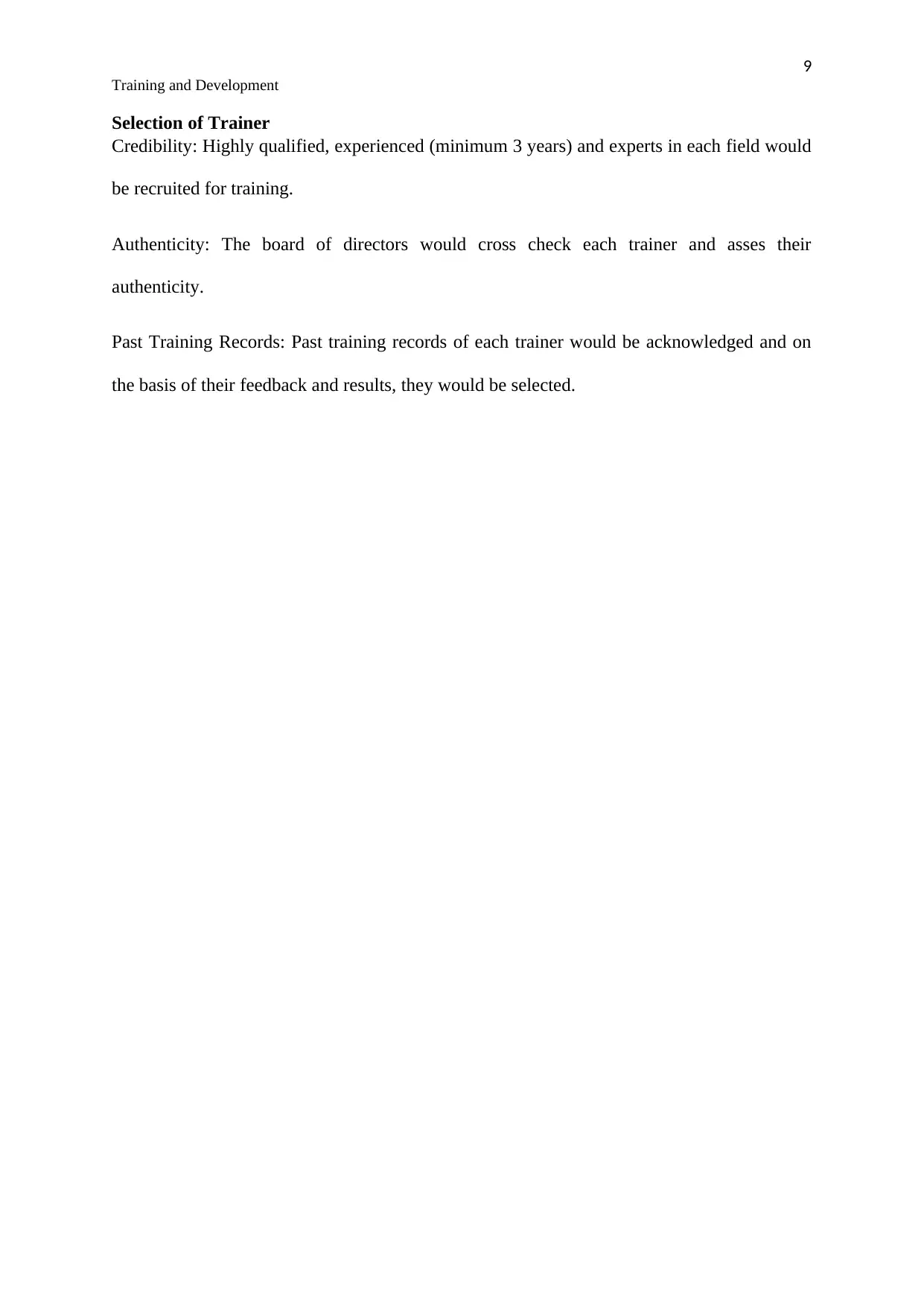
9
Training and Development
Selection of Trainer
Credibility: Highly qualified, experienced (minimum 3 years) and experts in each field would
be recruited for training.
Authenticity: The board of directors would cross check each trainer and asses their
authenticity.
Past Training Records: Past training records of each trainer would be acknowledged and on
the basis of their feedback and results, they would be selected.
Training and Development
Selection of Trainer
Credibility: Highly qualified, experienced (minimum 3 years) and experts in each field would
be recruited for training.
Authenticity: The board of directors would cross check each trainer and asses their
authenticity.
Past Training Records: Past training records of each trainer would be acknowledged and on
the basis of their feedback and results, they would be selected.
⊘ This is a preview!⊘
Do you want full access?
Subscribe today to unlock all pages.

Trusted by 1+ million students worldwide
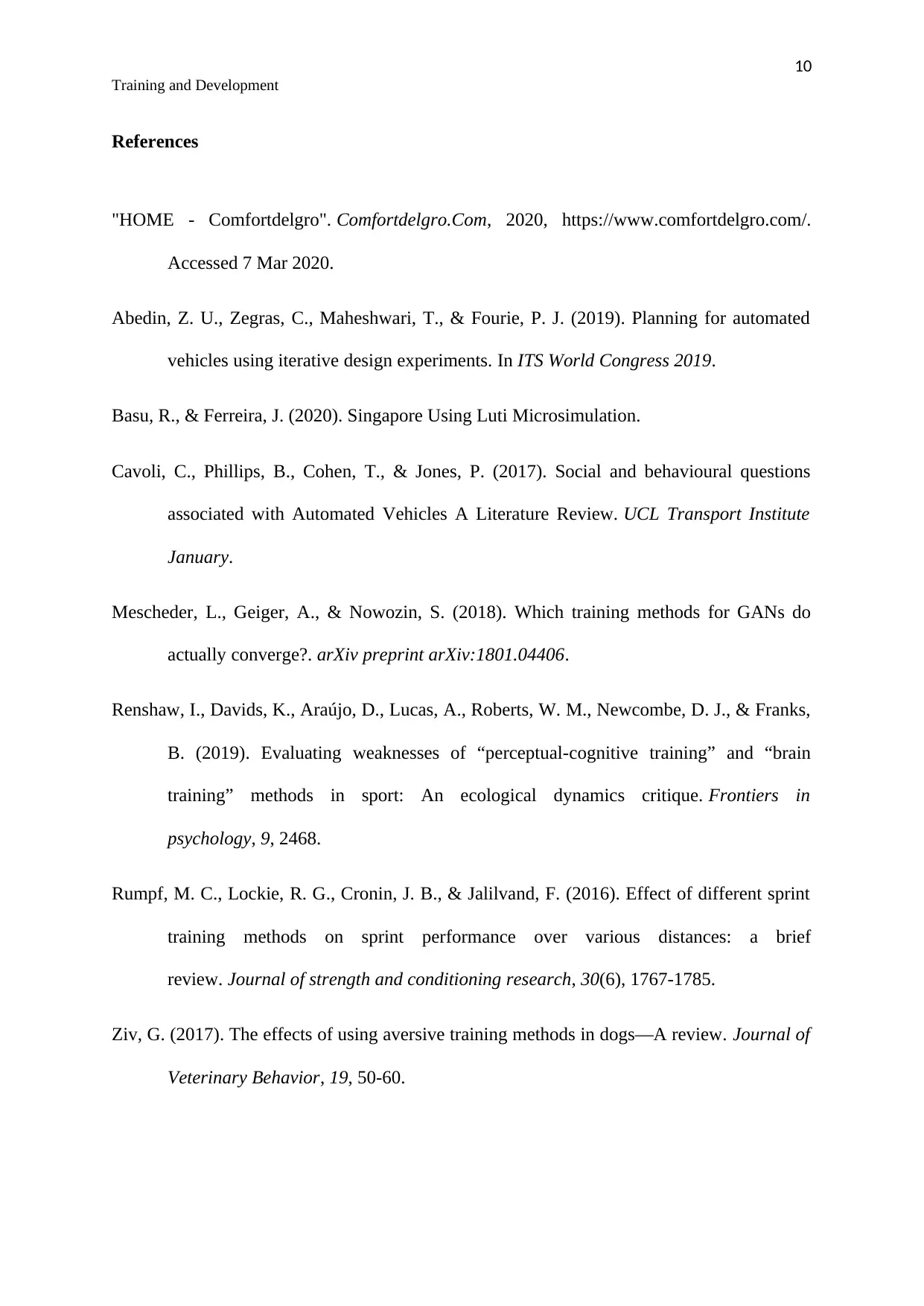
10
Training and Development
References
"HOME - Comfortdelgro". Comfortdelgro.Com, 2020, https://www.comfortdelgro.com/.
Accessed 7 Mar 2020.
Abedin, Z. U., Zegras, C., Maheshwari, T., & Fourie, P. J. (2019). Planning for automated
vehicles using iterative design experiments. In ITS World Congress 2019.
Basu, R., & Ferreira, J. (2020). Singapore Using Luti Microsimulation.
Cavoli, C., Phillips, B., Cohen, T., & Jones, P. (2017). Social and behavioural questions
associated with Automated Vehicles A Literature Review. UCL Transport Institute
January.
Mescheder, L., Geiger, A., & Nowozin, S. (2018). Which training methods for GANs do
actually converge?. arXiv preprint arXiv:1801.04406.
Renshaw, I., Davids, K., Araújo, D., Lucas, A., Roberts, W. M., Newcombe, D. J., & Franks,
B. (2019). Evaluating weaknesses of “perceptual-cognitive training” and “brain
training” methods in sport: An ecological dynamics critique. Frontiers in
psychology, 9, 2468.
Rumpf, M. C., Lockie, R. G., Cronin, J. B., & Jalilvand, F. (2016). Effect of different sprint
training methods on sprint performance over various distances: a brief
review. Journal of strength and conditioning research, 30(6), 1767-1785.
Ziv, G. (2017). The effects of using aversive training methods in dogs—A review. Journal of
Veterinary Behavior, 19, 50-60.
Training and Development
References
"HOME - Comfortdelgro". Comfortdelgro.Com, 2020, https://www.comfortdelgro.com/.
Accessed 7 Mar 2020.
Abedin, Z. U., Zegras, C., Maheshwari, T., & Fourie, P. J. (2019). Planning for automated
vehicles using iterative design experiments. In ITS World Congress 2019.
Basu, R., & Ferreira, J. (2020). Singapore Using Luti Microsimulation.
Cavoli, C., Phillips, B., Cohen, T., & Jones, P. (2017). Social and behavioural questions
associated with Automated Vehicles A Literature Review. UCL Transport Institute
January.
Mescheder, L., Geiger, A., & Nowozin, S. (2018). Which training methods for GANs do
actually converge?. arXiv preprint arXiv:1801.04406.
Renshaw, I., Davids, K., Araújo, D., Lucas, A., Roberts, W. M., Newcombe, D. J., & Franks,
B. (2019). Evaluating weaknesses of “perceptual-cognitive training” and “brain
training” methods in sport: An ecological dynamics critique. Frontiers in
psychology, 9, 2468.
Rumpf, M. C., Lockie, R. G., Cronin, J. B., & Jalilvand, F. (2016). Effect of different sprint
training methods on sprint performance over various distances: a brief
review. Journal of strength and conditioning research, 30(6), 1767-1785.
Ziv, G. (2017). The effects of using aversive training methods in dogs—A review. Journal of
Veterinary Behavior, 19, 50-60.
1 out of 10
Related Documents
Your All-in-One AI-Powered Toolkit for Academic Success.
+13062052269
info@desklib.com
Available 24*7 on WhatsApp / Email
![[object Object]](/_next/static/media/star-bottom.7253800d.svg)
Unlock your academic potential
Copyright © 2020–2025 A2Z Services. All Rights Reserved. Developed and managed by ZUCOL.





